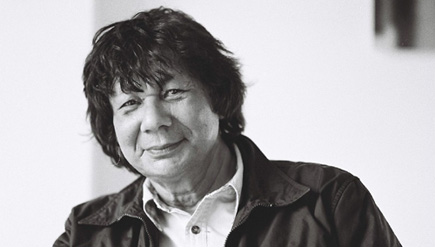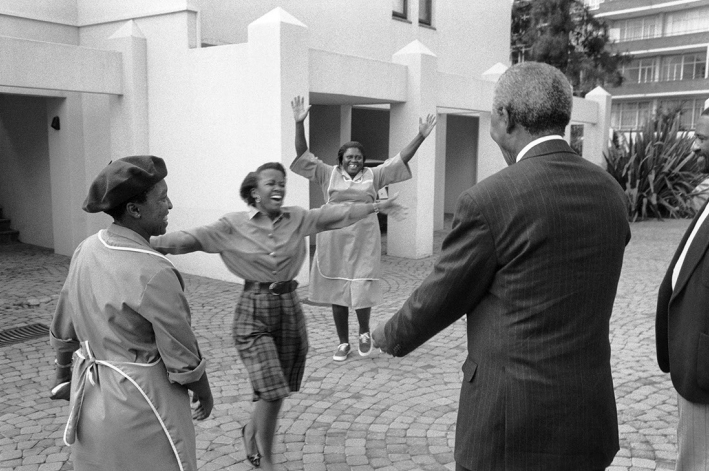Shortly before the inaugural ZAM Nelson Mandela Lecture started, an iconic picture of the South African freedom fighter and statesman found its way to the stage of the Amsterdam City Theatre. It was shot by George Hallett, who died in Cape Town on July 1st 2020.
‘You asked if I had an idea for a background image with the lecture’, said Sisonke Msimang on the morning of the lecture. It is February 10, 2019, just hours before this South African writer will deliver her lecture. The title: Rescuing Nelson Mandela from Sainthood.
Msimang takes out her phone and shows an image that George Hallett shot of Mandela in the first year of his presidency. At the suggestion of culture minister Pallo Jordan, the Cape photographer was hired to follow Mandela for a year. Hallett shot thousands of images, an interesting testimony to an historical era. After centuries of segregation and oppression by a white minority, South Africa has a black president for the first time.
In Here & Now, a book released in 2008, Hallett says of the photo:
‘That picture with the women running towards Mandela was the first time they had actually seen him close up. And it was an incredible experience, because for the first time I saw the whole country, and the joy and the hope that people had. My God, I thought — it's finally about to end, this crappy system of apartheid. And that was very inspirational’.
The image in the background impresses the visitors of the ZAM Nelson Mandela Lecture as much as the lecture by Sisonke Msimang, the dance of Faso!, the poetry of Nora el Koussour, the statement by Adriaan van Dis and the music of Jeangu Macrooy. But the name of the image maker is missing from the program booklet because it was only decided that morning to show it.
Perhaps that is also the fate of the photographer. More often than before, his name appears above the article depicting his work. Just as often as before, it can hardly be read in a futile credit next to the image.
Also on this 10th February 2019, the name of the creator of the image on the stage of the Amsterdam Stadsschouwburg is unknown to almost everyone. I was asked about the whereabouts afterwards. Fortunately, I know something, although it is fragmentary. His name is George Hallett and he lives in Cape Town and, yes, he is still alive. If I remember correctly he made a name for himself with portraits of South African jazz musicians who lived in exile in London, Paris and New York during apartheid. Just like Hallett, who fled his country in the 1970s. And, oh yes, he also lived in Amsterdam for ten years, I was told.
Hallett being commissioned by the South African government to follow Mandela in 1994? I had idea.
A few years ago a friend, who has since died, visited Hallett in Cape Town. For the Nelson Mandela Foundation she collected work related to the name giver of the foundation. Hallett donated some of his portraits of Mandela. ‘Such a nice man!’ she told me after the conversation. ‘And what an incredible collection!’
In addition to his work from the Mandela year, Hallett offered her a look at his jazz photos, some images from Amsterdam and District Six, which he photographed, among other things, at the urging of the Cape poet James Matthews before the rulers of the multicultural district in the center of Cape Town razed it to the ground. Matthews' poem Freedom Child was performed at the second ZAM Nelson Mandela Lecture by jazz singer Melanie Scholtz. It was 1 March when this ode to freedom captured the audience, only 10 days before we all found ourselves in lockdown.
Tradition has it that Hallett was known to some people as ‘troublesome’. It is a predicate that artists often receive. Mostly it concerns quirkiness, the ability to combine loyalty to ideals with a course of ones' own. Sometimes the photographer (or the musician, or the theatre maker) is called 'difficult' because he or she does not always want to be asked to work for the good cause by people who are often paid themselves. And, yes, perhaps Hallett was sometimes troublesome, because living in exile feels like a burden that becomes increasingly difficult to bear as the years go on.
Now that George Hallett has died, obituaries appear and they further colour his life. And from all those images of Hallett himself, which accompanies the stories, the same joy de vivre shows as on image that made the inaugural ZAM Nelson Mandela Lecture so complete.

Watch the image & Sisonke Msimang's lecture here.
Read more about George Hallet's life here.


